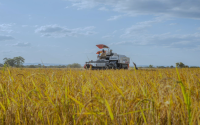Ghana Sets Eyes on Food Security and Resilience through Planting for Food and Jobs Phase II
The dawn of an agricultural renaissance is on Ghana’s horizon. As nations globally grapple with issues of food scarcity and the challenges of a changing climate, Ghana is setting the pace with its bold and visionary project, the Planting for Food and Jobs Phase II (PFJ 2.0).
Amidst the eloquent architecture of Accra’s Presidential Palace, at a meticulously arranged Breakfast Meeting on Agriculture and Agribusiness Financing, Bryan Acheampong, Minister for Food and Agriculture, confidently delineated Ghana’s next big agricultural stride.
“Our destiny lies in our hands, and it is one of growth, self-reliance, and resilience,” Minister Acheampong began, his words reflecting Ghana’s agricultural aspirations.
Decoding the Numbers
The PFJ 2.0 is not just an amalgamation of promises. It’s an action-oriented, numbers-backed strategy. The nation has set its trajectory from a mere 5% self-sufficiency rate in early 2023 to an impressive 7% by the end of this year. By 2024, the bar rises to 13%. The climax? An enviable 110.6% by 2028. But what does this surge imply?
In layman’s terms, not only will Ghana be able to satiate its own food requirements, but it will also produce surplus, potentially becoming a key food exporter in the African continent.
Immediate Steps: Poultry as a Precursor
One of the spearheading initiatives involves poultry. The Ministry of Food and Agriculture (MoFA) has committed to distributing 4.5 million day-old chicks, supplemented by essential vaccines and starter feeds, to the backbone of Ghana’s agricultural scene – the anchor farmers and their outgrowers.
“This alone will account for an addition of 13,200 MT of poultry meat, nudging our self-sufficiency rate to 7%,” a MoFA representative shared. It’s an assertive move, one that underscores the nation’s immediate commitment to its agricultural vision.
Beyond Immediate Steps: A Holistic Approach
Yet, PFJ 2.0 is more than just poultry. It’s a panoramic, 360-degree view of the agricultural spectrum. Here’s what’s in store:
- Subsidized Farming Inputs: A significant hurdle for many farmers is the high cost of quality inputs. Through PFJ 2.0, farmers will gain easier access to seeds, fertilizers, and pesticides, all at subsidized rates.
- Financial Empowerment: An integrated approach to finance, including accessible credit facilities and bespoke financial services, ensures that farmers don’t have to worry about capital.
- Training and Knowledge Dissemination: A well-informed farmer is an empowered one. Through enhanced extension services, training modules, and workshops, Ghanaian farmers will be equipped with the latest in agricultural knowledge and techniques.
- Infrastructure: It’s not just about seeds and training. The nation is set to witness a surge in infrastructure investments, especially in areas like irrigation, which can make or break a crop season.
- Private Sector Involvement: PFJ 2.0 is reaching out, fostering public-private partnerships. The aim? To get the corporate sector actively involved in the agricultural tapestry, propelling investments, innovations, and market access.
Wrapping up the detailed unveiling of PFJ 2.0, Minister Acheampong emphasized unity and collective effort. “We’re on the brink of an agricultural metamorphosis, and it’s a journey we embark on together,” he resonated, leaving stakeholders with a sense of purpose and a vision to rally behind.


